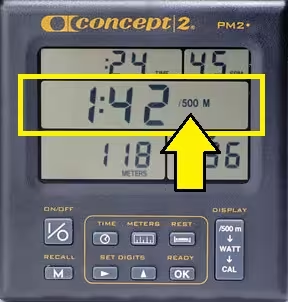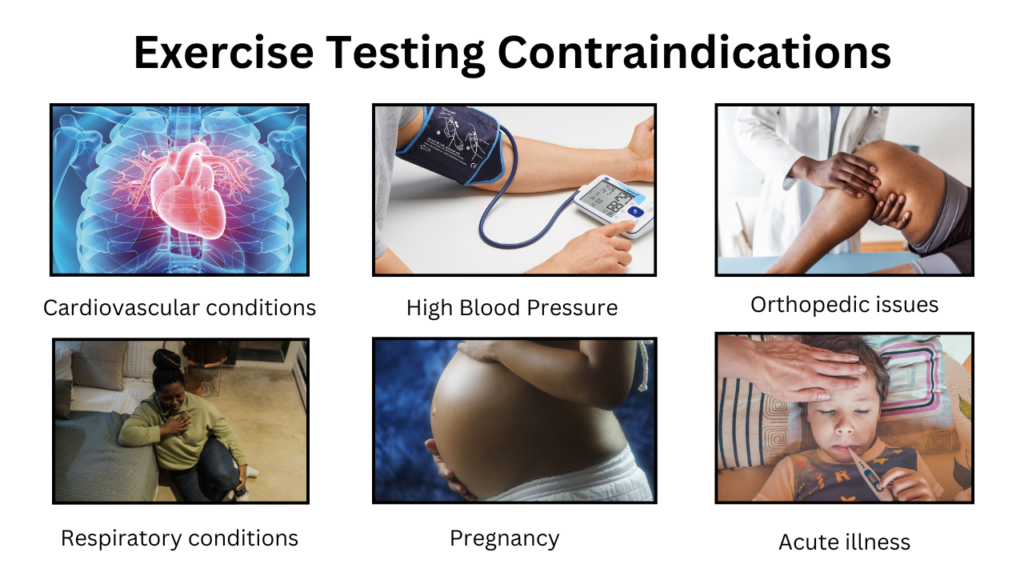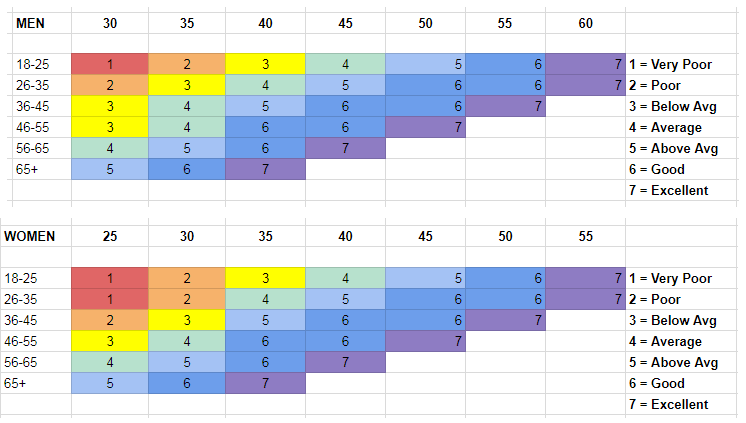VO2 max is a measure of the maximal volume of oxygen your body can use and it’s a good indicator of cardiovascular fitness. A true VO2 max test is conducted in a lab and involves exercising to failure while wearing a mask.
However, there are simple tests that can provide an estimate of your VO2 max. I’ve previously covered a maximal effort test called the Cooper Test, another maximal test is the 2000m Rowing Test.
What is the 2000m Rowing Test
The 2000m row on a rowing machine was used by Dr. Fritz Hagerman to create a formula for predicting VO2 max. He had thousands of subjects complete a 2000m row, many of whom took a “true” VO2 max test for comparison. The results were used to create a formula based on 2000m rowing time, sex, weight and rowing experience.
Rowing experience is divided into “highly trained” and “not highly trained”. The former would be someone who has rowed multiple times per week for several years with the goal of improving their times. This is likely to account for an efficiency in stroke technique that would allow them to cover 2000m faster than an inexperienced rower of the same fitness level.
The highly trained cohort are split into two weight categories, at 61.36kg for women, and 75kg for men. We are therefore left with six different formulae. The time taken in minutes to complete the 2000m row is represented as the variable time_in_minutes.
Highly Trained
- Female, up to 61.36kg: (14.6 – (1.5 * time_in_minutes)) * 1000 / weight_in_kg
- Female, over 61.36kg: (14.9 – (1.5 * time_in_minutes)) * 1000 / weight_in_kg
- Male, up to 75kg: (15.1 – (1.5 * time_in_minutes)) * 1000 / weight_in_kg
- Male, over 75kg: (15.7 – (1.5 * time_in_minutes)) * 1000 / weight_in_kg
Not Highly Trained
- Female: (10.26 – (0.93 * time_in_minutes)) * 1000 / weight_in_kg
- Male: (10.7 – (0.9 * time_in_minutes)) * 1000 / weight_in_kg
A 2000m row VO2 max calculator can be found on the concept2 website, I have included some example scenarios below.

It’s hopefully clear how much difference body-weight makes to estimated VO2 max. A 60kg woman rowing in 8 minutes 30 seconds has the same VO2 max as a 70kg woman rowing in 8 minutes flat. Losing excess fat while maintaining performance output is a great way to improve your VO2 max.

For a younger man, average VO2 max is in the region of 40 to 45 ml/kg/min. That means depending on their weight they should be capable of rowing 2000m in under 9 minutes.
How To Do The 2000m Rowing Test
While the VO2 max estimates do account for people who are not highly trained rowers, that’s not the same as someone with no experience at all. If you rarely use a rowing machine it’s likely that your technique is not refined enough for this test to be accurate. In general, it’s recommended that estimated VO2 max tests are conducted on the training modality you have most experience with. Runners are better off with the Cooper Test and cyclists with the Åstrand-Rhyming Test.
If you are comfortable on a rowing machine, the test will require a thorough warm up followed by a maximal effort for 2000 metres. Most rowing machines allow you to preset this distance so that your time will display when 2000 metres has been covered. The damper setting, often mistaken for a “resistance” lever, should be set based on individual needs. Most users find a damper setting between 3 and 5 leads to the fastest 2000m times.

How To Pace Yourself For The 2000m Rowing Test
One drawback of the 2000m Rowing Test for those who are not highly trained is knowing how to pace yourself. If you don’t regularly row 2000m flat out then you may have no idea how fast you should set off. A workaround is to complete a submaximal estimated VO2 max test and use that result to determine a theoretical distance you could achieve.
If you first completed the Rockport Walking Test you would have an estimate of your VO2 max. By looking up the time you’d need to cover 2000m in the rowing test to achieve the same score, you have a reasonable starting estimate. Alternatively, make a fair estimate of your expected fitness level and find the appropriate time.
Reversing the original equations for “not highly trained” subjects gives the following:
- Female time (minutes) = 11.03 – ((estimated_vo2_max * weight_in_kg) / 930)
- Male time (minutes) = 11.89 – ((estimated_vo2_max * weight_in_kg) / 900)
Using myself as an example:
- My estimated VO2 max from the Rockport Walking Test was 51.8 ml/kg/min.
- I am not highly trained and my weight is 71kg.
- Finding 51.8 on the y axis of the Male, Not Highly Trained graph above equates to roughly 7:50 on the x axis.
- If I plug it into the equation above, I get 11.89 – ((51.8 * 71) / 900 = 7.80 minutes, or 7:48.

A 2000m row is typically thought of as four sections of 500 metres. If I was to aim for 7:48 that would be a pace of 1:57 / 500m. You will find that many rowing machines display your 500m pace as you row.
Contraindications
There are certain individuals for whom exercise testing is contraindicative. Below are the most common conditions that may prevent you from safely completing this test.

What do my results mean
Your results are best compared relative to others of the same age and sex. Below is a set of normative data for VO2 max for both men and women. What constitutes “average” can vary between research studies due to the population samples they use.

At the top end, elite athletes average 55-65 ml/kg/min with endurance specialists able to reach 75-85 ml/kg/min. Cross Country Skiers are often touted as the athletes who score the highest, with some managing to score 90-95 ml/kg/min on their VO2 max tests.
At the lower end of the scale, an unfit 65 year old may start dipping under 20 ml/kg/min. This would mean walking uphill would be right at the limit of their capabilities. A VO2 max this low may start to infringe on other activities of daily living.
Tracking VO2 max over time
There is a very well established decline in VO2 max with age, and that happens regardless of fitness level. The difference is that a fitter individual will remain at a higher level relative to the unfit individual as they both age.
While it’s a relatively intense test to take, completing it once a year will help you track fitness over time. People typically lose 1% of their VO2 max a year, so even if you maintain your activity levels, you will see a decline with age. Here I’ve included my results, which come from a range of different tests including maximal tests like the 2000m row, Cooper Test and Bleep Test.

One important point to remember about a maximal test is that it requires a much higher degree of motivation. I’m confident that explains the difference between the red and black lines above. To bridge the gap of +2.5 ml/kg/min I would need to have rowed 2000m around 12 to 15 seconds faster.
Your VO2 max is very much trainable if you are willing to put in the hours. This is particularly true if you are currently sedentary, which would put you more at risk as you approach 65 or older. Improving VO2 max is beyond the scope of this article, but a common routine is to do a 4 minute row followed by 4 minutes rest, and repeat that four times.

